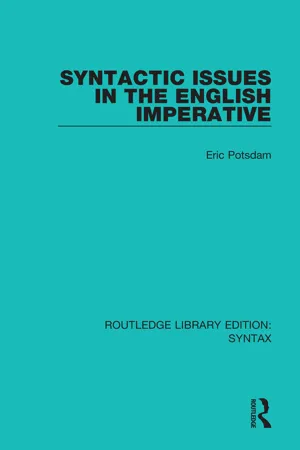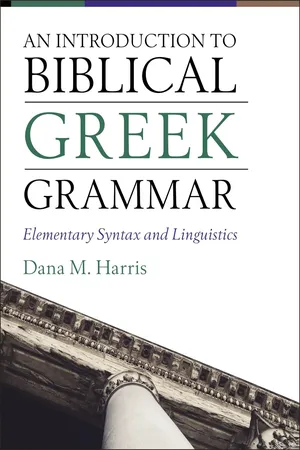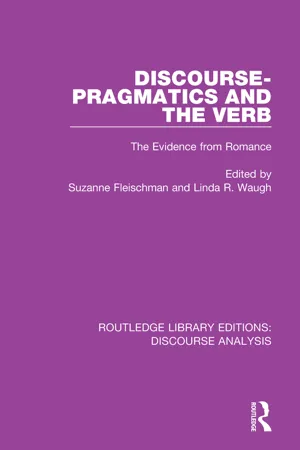Imperatives
Imperatives are a type of verb form used to give commands, instructions, or requests. They are typically characterized by their directness and lack of subject pronouns. In English, imperatives are often formed using the base form of the verb, and they play a crucial role in communication by allowing speakers to convey orders or make suggestions.
4 Key excerpts on "Imperatives"
- eBook - ePub
- Eric Potsdam(Author)
- 2017(Publication Date)
- Routledge(Publisher)
...Under a semantic characterization, any construction with the relevant illocutionary force or pragmatic effect may be classified as an imperative, irrespective of its form. Such a description is fundamentally one based on linguistic use and it defines an imperative as a SPEECH ACT TYPE (see the philosophical literature including Austin 1962 and Searle 1969). For example, such an approach potentially labels all of the examples in (1) as Imperatives because they all have approximately the same force in a certain situation. I will refer to this speech act type as DIRECTIVE but will not attempt to explicate it (but see chapter 3, section 4 as well as Katz and Postal 1964, Broadie 1972, Stockwell et. al. 1973, Downes 1977, Schmerling 1982, Davies 1986a, and Hamblin 1987). (1) a. Close the window! b. You should close the window! c. Will you close the window, please? d. The window ought to be closed, John. While such a classification is useful in describing language's communicative potential and actual use, it does not make any claims about the syntactic structure of such sentences. Typically, however, there is one particular sentence form which is considered the canonical syntactic realization of a given semantic clause type and this allows us to relate a speech act type to the syntax. I will define an IMPERATIVE to be the syntactic sentence form which is the canonical realization of a directive speech act type. In addition to being unified by a canonical use, Imperatives also share core syntactic or morphological properties. (2) is a set of criteria for the English imperative, adapted from Davies 1986a:7, which I will use to further characterize the English imperative clause type. Under this view, the imperative is a SYNTACTIC CLAUSE TYPE. See Davies 1986a; chapter 1 for considerable discussion. (2) Characteristics of the English Imperative Clause Type a lack of tense inflection b...
- eBook - ePub
An Introduction to Biblical Greek Grammar
Elementary Syntax and Linguistics
- Dana M. Harris(Author)
- 2020(Publication Date)
- Zondervan Academic(Publisher)
...chapter TWENTY-TWO THE IMPERATIVE: Forms and Functions; More Pronouns OBJECTIVES AND OVERVIEW Chapter 22 introduces the following linguistic concepts, morphemes, and paradigms: • imperative personal endings • present active and middle imperative paradigms • aorist active, middle, and passive imperative paradigms • forms of Imperatives for contract verbs • imperative paradigm of εἰμί • functions of the imperative: command, prohibition • translation of third-person Imperatives • first-, second-, and third-person reflexive-pronoun paradigms • reciprocal-pronoun paradigm THE IMPERATIVE: FORMS AND FUNCTIONS So far, we have looked at two finite moods, the indicative and the subjunctive. In this chapter we learn a third finite mood, the imperative. The indicative mood makes an assertion or statement. The subjunctive mood is the mood of probability or potentiality. The imperative mood is used to communicate a command. It is the mood of intention and involves volition; it is the attempt to direct someone’s actions. As with the subjunctive mood, the primary opposition in the imperative mood is between the present tense stem and the aorist tense stem. 1 Imperatives only occur in direct discourse and never in the parts of narrative that record events that took place (they do, of course, occur in the recorded speeches within those narratives). Moreover, Imperatives only occur in main clauses. The Forms of the Imperative Imperative forms only occur in the second and third person. As we noted previously, there is a functional overlap between the subjunctive and the imperative, which is summarized as follows: Command 1st person hortatory subjunctive 2nd person imperative 3rd person imperative The present and aorist tense stems are used to build the imperative. Additionally, there are different sets of endings that are used with the imperative, which need to be memorized. These distinctive endings are the biggest formal clue for recognizing the imperative...
- eBook - ePub
Discourse Pragmatics and the Verb
The Evidence from Romance
- Suzanne Fleischman, Linda R. Waugh, Suzanne Fleischman, Linda R. Waugh(Authors)
- 2016(Publication Date)
- Routledge(Publisher)
...6 The status of Imperatives as discourse signals 1 Béatrice Lamiroy and Pierre Swiggers 1. Introduction 1.1. Theoretical introduction The last decades have witnessed a strong interest in theories of énonciaiion, and, at a deeper level, a move away from a grammar-focused approach toward a communication-centered one. 2 In two recent books, Hagège (1982, 1985) has integrated the latter type of approach into a general theory of language, relating it to an "enunciativehierarchical point of view." This contrasts with a morphosyntactic point of view, which focuses on formal (including positional) and functional aspects of linguistic units above the phoneme-level. By "function" we understand here "internal function," thus a reference to the relation of linguistic units to the language system. In such a view "function" can be opposed to "use." (One could also speak of function 1 and function 2, the latter referring then to the relation between language units and language users. 3) The grammatical tradition has largely eschewed usage-based definitions of linguistic units on the morphosyntactic level. While this may be due to an awareness (never explicitly acknowledged) that form and function (i.e. function 1) allow one to define linguistic units in a much more operational way, one might well wonder whether this situation is not due to a "subordinate" attitude on the part of grammarians, who often prefer (or preferred) to walk in the footsteps of logicians and language pedagogues who have insisted on formal and content-based classificatory criteria. This is not the proper place to embark upon a broad-gauged investigation of a striking inertia in the history of linguistics. However several observations are relevant in this context: (a) the remarkable longevity of the parts-of-speech approach (cf...
- eBook - ePub
- C. I. Lewis, John Lange, John Lange(Authors)
- 2017(Publication Date)
- SUNY Press(Publisher)
...ESSAY 4 Semantics of the Imperative H owever we may think of ethics nowadays, it is evident enough that it first became articulate as something taught, and not taught as information merely but inculcated, preached. The topic is how to behave yourself, what is to be done and what not done, precepts of action, and particularly of those acts which, by affecting others than the doer, become matters of common concern amongst us. The content of ethics is something exhorted to or dictated: dictated by parents to children, by responsible leaders to obedient followers, by the elders of the tribe to the initiates, by those possessed of wisdom or learning to those who are ignorant or inexpert. Or it may be resolutions we make against the future, or recommendations we venture to our peers, or pledges we recite together in some ritualistic confirmation of our mutual intent. This content is expressible, if not expressed, in the imperative mood. But every mood of language must be stretched to cover a considerable range and variety of our mental entertainments of the content to be conveyed. Just as our words must metonymically acquire second and third meanings, by reason of the insufficiency of the vocables we can shortly pronounce and recognize to the number of distinguishable kinds of things and characters of things which we discriminate, so also the syntactic inflections and constructions we can contrive for our putting together of words must be insufficient to our ways of entertaining what our sentences make mention of. All sentences have it in common that they refer to some indicated state of affairs, representationally contemplated by the speaker and likewise to be thought of by any addressee. Perhaps other creatures command only one mood of communication—“Take notice”—and can convey nothing beyond the immediately observed and felt. But what humans speak of may be present or absent, here or there, or halfway around the world...



